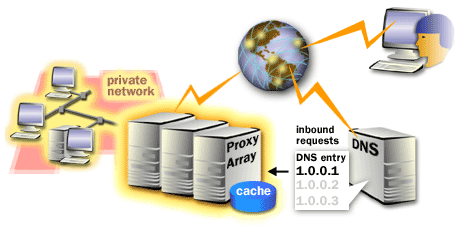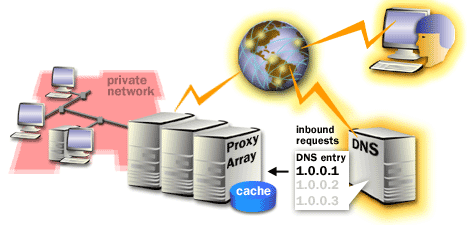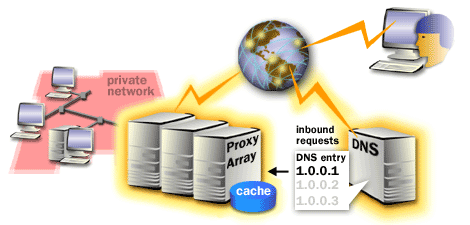| Lesson 6 | Distributing IP traffic across multiple proxy servers |
| Objective | Describe the strategies used to distribute IP traffic across multiple proxy servers. |
Distributing IP traffic across multiple proxy servers
You can optimize the performance of a Proxy Server solution by distributing IP traffic across multiple proxy servers in various ways: by using round-robin DNS entries, by establishing proxy arrays, or by using Network Load Balancing. You will decide which method for load-balancing IP traffic is most appropriate based upon whether the:
- Direction of the IP traffic is inbound or outbound
- Load-balancing method distributes IP traffic dynamically or statically
| If you need to support: | You will use: | ||
| Proxy arrays | Round-robin DNS | Network Load Balancing | |
| Inbound traffic (Internet-based requests) | No | Yes | Yes |
| Outbound traffic (private network-based requests) | Yes | No | No |
| Dynamic/static load balancing | Dynamic | Static | Dynamic |
Now that you know which method will optimize Proxy Server performance, you need to decide what the needs of your system are. Otherwise, how can you be sure that using round-robin DNS to optimize outbound traffic will improve the particular networking needs of your organization better than Network Load Balancing? The table that follows will give you a better sense of how these different
optimization methods work.
Proxy arrays for outbound client requests

DNS Round Robin

Specify a DNS A-type resource record for each computer running Proxy Server on a DNS server that supports DNS Round Robin. The resource records include the same DNS domain name with the IP address for each respective proxy server. By returning the IP address of a different proxy server for each request, Internet-based client requests are load balanced. You should select round-robin DNS entries to 1) improve the performance of private network access for Internet clients, and 2) provide the improvement in performance without using Network Load Balancing.
Network Load Balancing

You can specify a DNS A-type resource record for the proxy servers in the same Network Load Balancing cluster. The resource record includes the DNS domain name and the IP address of the Network Load Balancing cluster. The remote client sends an inbound request to Network Load Balancing, the proxy servers in the Network Load Balancing evaluate the request, and one of the proxy servers responds to the request. You should select Network Load Balancing to 1) improve the performance of private network access for Internet clients, and 2) provide dynamic load balancing across the proxy servers in the Network Load Balancing cluster.
Question:
What are the connectivity problems that most commonly affect your organization? And which strategies are you most likely to implement? Tell you classmates. The next lesson will wrap up this module.